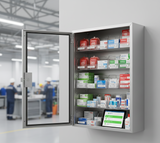Beyond the Dust Bunnies: Why Good Housekeeping is Essential for Workplace Safety
Okay, here's the draft blog post for "Beyond the Dust Bunnies: Why Good Housekeeping is Essential for Workplace Safety," designed to highlight a foundational, yet often underestimated, aspect of workplace safety.
Beyond the Dust Bunnies: Why Good Housekeeping is Essential for Workplace Safety
When you envision a "safe workplace," you might picture hard hats, safety goggles, or emergency eyewash stations. And while these are all crucial elements, one of the most fundamental, yet frequently overlooked, aspects of a truly safe environment is something far simpler: good housekeeping.
Often dismissed as merely "tidying up," effective workplace housekeeping is a proactive safety measure that prevents a multitude of hazards, from the most common slips and trips to more serious fires and chemical exposures. It’s about maintaining orderly conditions, keeping work areas clean, and controlling potential dangers before they escalate.
At Your Safety Company, we understand that a clean and organized workspace isn't just aesthetically pleasing; it's a cornerstone of a robust safety culture. Let’s sweep away the misconceptions and uncover why good housekeeping is essential for every business.
More Than Just Tidy: The Hidden Dangers of Poor Housekeeping
A messy workplace isn't just unprofessional; it's a breeding ground for accidents and inefficiencies. Here are some of the critical hazards poor housekeeping can create:
-
Slips, Trips, and Falls (STFs):
-
The most common workplace injuries. Clutter on floors, spilled liquids, loose cords, unrolled mats, or obstructed walkways are prime culprits.
-
Impact: Broken bones, sprains, head injuries, lost work time, and workers' compensation claims.
-
-
Fire Hazards:
-
Accumulation of combustible materials (paper, rags, wood, packaging) near heat sources, electrical equipment, or in areas with flammable liquids significantly increases fire risk.
-
Impact: Property damage, severe injuries, business interruption.
-
-
Chemical and Hazardous Material Exposures:
-
Improperly stored chemicals, unlabeled containers, or uncleaned spills can lead to skin contact, inhalation, or dangerous reactions.
-
Impact: Chemical burns, respiratory issues, environmental contamination.
-
-
Falling Objects:
-
Overstacked shelves, unstable piles of materials, or items stored precariously overhead can dislodge and fall, causing head or foot injuries.
-
-
Obstructed Emergency Exits and Equipment:
-
Blocked fire exits, emergency showers, eyewash stations, electrical panels, or fire extinguishers can prevent quick access in an emergency, turning a minor incident into a major disaster.
-
-
Pest Infestations:
-
Food debris, stagnant water, and general clutter can attract rodents and insects, leading to hygiene issues and potential health risks.
-
The Benefits of a Sparkling Safety Strategy
Implementing and maintaining good housekeeping isn't just about avoiding problems; it brings tangible benefits to your business:
-
Reduced Accidents: Directly lowers the risk of STFs, fires, and other incidents.
-
Improved Efficiency: An organized workspace allows employees to find tools and materials faster, reducing wasted time and effort.
-
Enhanced Employee Morale: A clean and safe environment shows employees you value their well-being, fostering a more positive work culture.
-
Better Inventory Management: Clear storage areas mean better tracking of supplies and reduced waste.
-
Professional Image: A tidy workplace projects professionalism to clients and visitors.
-
Compliance: Helps meet regulatory standards for workplace safety and hygiene.
Practical Steps for Impeccable Workplace Housekeeping
Making good housekeeping a habit requires a systematic approach and commitment from everyone.
-
"A Place for Everything, and Everything in Its Place":
-
Designate specific storage locations for tools, materials, and equipment.
-
Ensure shelving and storage units are stable and appropriate for the load.
-
Use clear labeling for all storage areas and containers.
-
-
Keep Walkways & Exits Clear:
-
Mark aisles and pedestrian pathways clearly with floor tape or paint.
-
Ensure all emergency exits, fire fighting equipment, electrical panels, and first aid stations are always unobstructed.
-
-
Prompt Spill Cleanup:
-
Train employees on immediate spill response procedures.
-
Keep appropriate spill kits readily accessible, especially in areas where liquids or chemicals are handled.
-
-
Manage Waste Effectively:
-
Provide sufficient waste receptacles, clearly labeled for recycling, general waste, or hazardous waste.
-
Empty bins regularly to prevent overflow and accumulation of combustibles.
-
-
Control Dust & Debris:
-
Implement regular cleaning schedules.
-
Use appropriate dust collection systems in dusty environments.
-
-
Regular Inspections & Employee Engagement:
-
Conduct routine housekeeping inspections.
-
Encourage all employees to take ownership of their work areas and report hazards immediately. Make housekeeping part of daily routines.
-
Good housekeeping is the invisible framework that supports all other safety initiatives. By preventing clutter, controlling spills, and ensuring clear access to critical safety equipment, you significantly reduce risks across your entire operation.
Recent Posts
-
Beyond the Big Box: Why Yoursafetycompany.com is the Smarter Choice for Your First-Aid Program
When it comes to workplace first aid, ensuring your business is compliant and your employees are pro …1st Jan 2026 -
The 2026 Safety Checklist: Is Your Crew Truly Protected?
As we move into the new year, it’s the perfect time to look past the daily grind and evaluate the ge …23rd Dec 2025 -
Beyond the Buzz: Why Proper Hearing Protection is Non-Negotiable on Your Job Site
On any given workday, the sounds of progress—drills, saws, heavy machinery, and even loud conversati …22nd Dec 2025


